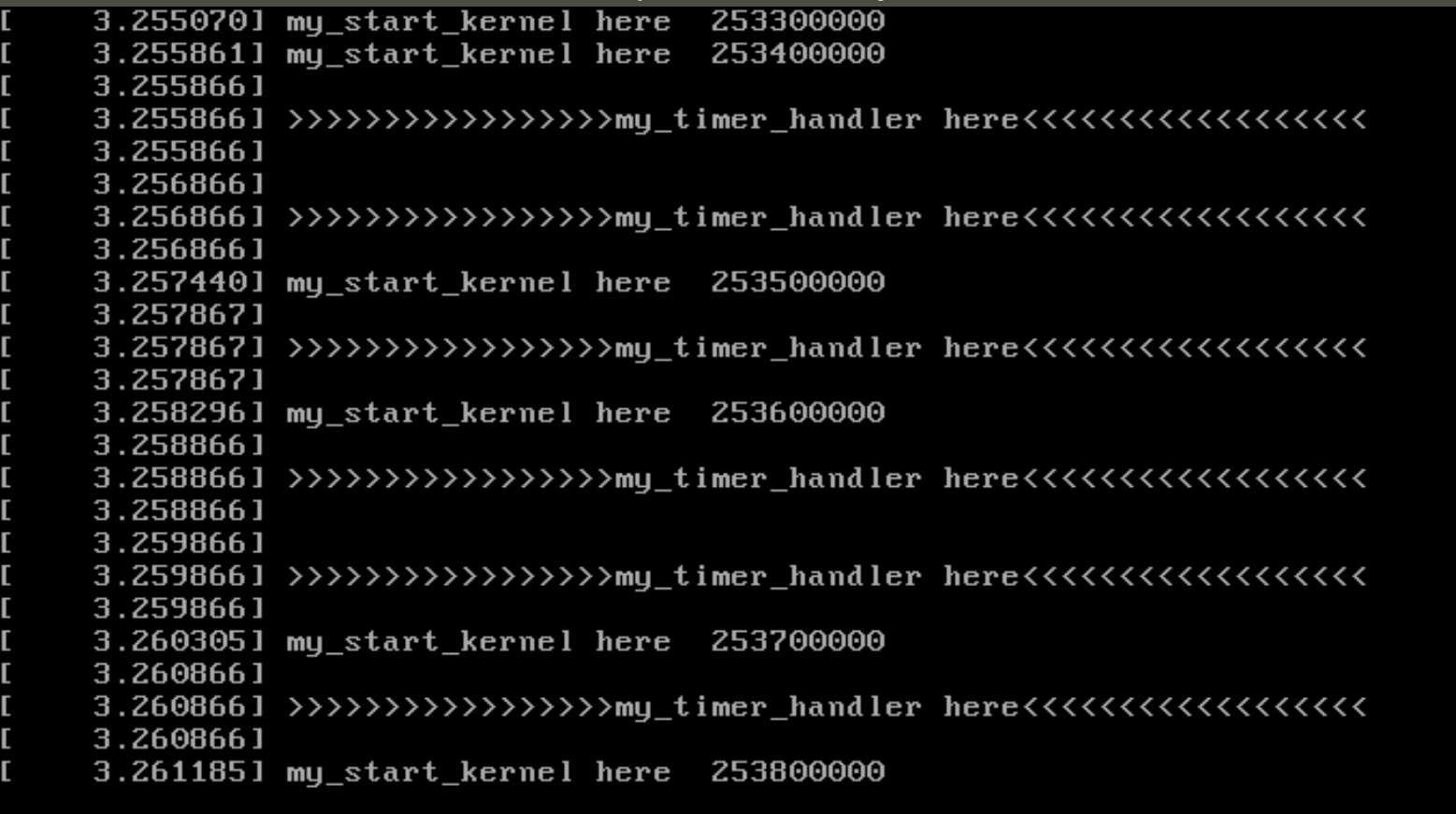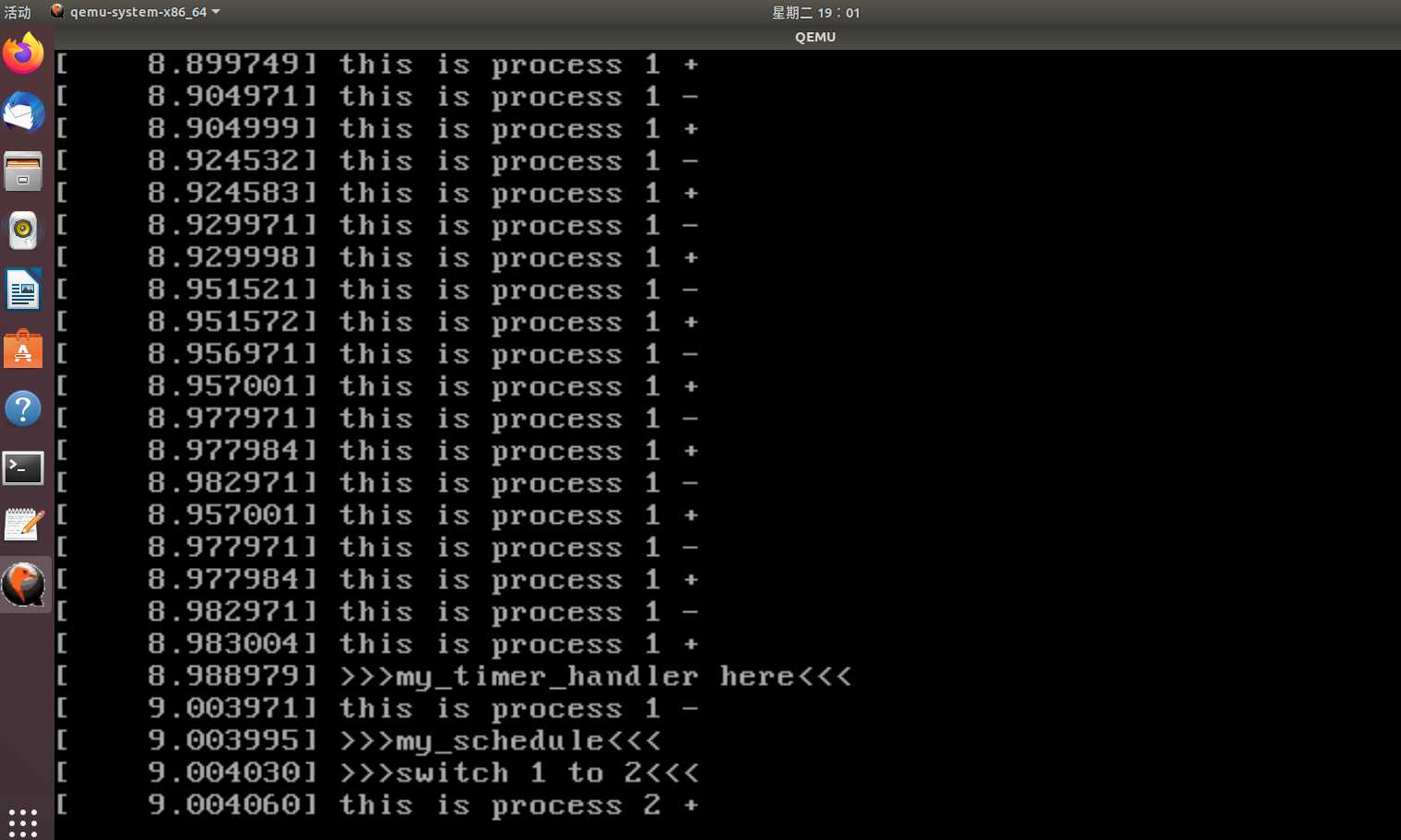标签:cpu git amp 更换 inux c中 s函数 sharp count
------------恢复内容开始------------
一、实验要求
二。本机环境:VMware Workstation+虚拟机Ubuntu 18.04.4 LTS amd64。
三、实验步骤:
1)下载Linux内核并进行配置、运行:
wget https://raw.github.com/mengning/mykernel/master/mykernel-2.0_for_linux-5.4.34.patch(这一步从群里下载直接复制过来即可)
sudo apt install axel
axel -n 20 https://mirrors.edge.kernel.org/pub/linux/kernel/v5.x/linux-5.4.34.tar.xz
xz -d linux-5.4.34.tar.xz
tar -xvf linux-5.4.34.tar
cd linux-5.4.34
patch -p1 < ../mykernel-2.0_for_linux-5.4.34.patch
sudo apt install build-essential libncurses-dev bison flex libssl-dev libelf-dev
make defconfig # Default configuration is based on ‘x86_64_defconfig‘
make -j$(nproc)
sudo apt install qemu # install QEMU
qemu-system-x86_64 -kernel arch/x86/boot/bzImage
2)模拟器运行结果如下:

就可以看到QEMU窗?输出的内容的代码mymain.c和myinterrupt.c ,当前有?个虚拟的CPU执?C代码的上下?环境,可以看到mymain.c中的代码在不停地执?。同时有?个中断处理程序的上下?环境,周期性地产?的时钟中断信号,能够触发myinterrupt.c中的代码。这样就通过Linux内核代码模拟了?个具有时钟中断和C代码执?环境的硬件平台。
打开mykernel文件夹下的mymain.c以及myinterrupt.c文件,可以看到里面的代码有如下几段:
mymain.c中是一个死循环,不断输出"my_start_kernel here %d \n",myinterrupt.c中则不断输出时钟中断"my_timer_handler here"。而根据之前qemu的运行结果,可以看出进程和时钟中断不断的交替运行。而我们要做的事情就是写一个自己的进程控制块以及进程调度算法,从而实现模拟多个进程调度运行。
void __init my_start_kernel(void)
{
int i = 0;
while(1)
{
i++;
if(i%100000 == 0)
printk(KERN_NOTICE "my_start_kernel here %d \n",i);
}
}
void my_timer_handler(void)
{
printk(KERN_NOTICE "\n>>>>>>>>>>>>>>>>>my_timer_handler here<<<<<<<<<<<<<<<<<<\n\n");
}
3)基于mykernel 2.0编写一个操作系统内核,参照https://github.com/mengning/mykernel 提供的范例代码
a.首先在mykernel目录下增加一个mypcb.h 头文件,用来定义进程控制块(Process Control Block),也就是进程结构体的定义,在Linux内核中是struct tast_struct结构体
#define MAX_TASK_NUM 4
#define KERNEL_STACK_SIZE 1024*8 //进程堆栈大小
/* CPU-specific state of this task */
struct Thread { //存储ip,sp
unsigned long ip;
unsigned long sp;
};
typedef struct PCB{
int pid; //进程的id
volatile long state; //表示进程的状态,-1表示就绪状态,0表示运行状态,1表示阻塞状态
char stack[KERNEL_STACK_SIZE]; //内核堆栈
/* CPU-specific state of this task */
struct Thread thread;
unsigned long task_entry; //指定的进程入口,平时入口为main函数
struct PCB *next; //指向下一个进程控制块的指针,进程控制块间用链表连接
}tPCB;
void my_schedule(void); //函数调度
b. 对mymain.c中的my_start_kernel函数进行修改,并在mymain.c中实现了my_process函数,用来作为进程的代码模拟一个个进程,时间片轮转调度:
#include "mypcb.h"
tPCB task[MAX_TASK_NUM];
tPCB * my_current_task = NULL;
volatile int my_need_sched = 0;
void my_process(void);
void __init my_start_kernel(void)
{
int pid = 0;
int i;
/* Initialize process 0*/
task[pid].pid = pid;
task[pid].state = 0;/* -1 unrunnable, 0 runnable, >0 stopped */
task[pid].task_entry = task[pid].thread.ip = (unsigned long)my_process;
task[pid].thread.sp = (unsigned long)&task[pid].stack[KERNEL_STACK_SIZE-1];
task[pid].next = &task[pid];
/*fork more process */
for(i=1;i<MAX_TASK_NUM;i++)
{
memcpy(&task[i],&task[0],sizeof(tPCB));
task[i].pid = i;
task[i].state = -1;
task[i].thread.sp = (unsigned long)&task[i].stack[KERNEL_STACK_SIZE-1];
task[i].next = task[i-1].next;
task[i-1].next = &task[i];
}
/* start process 0 by task[0] */
pid = 0;
my_current_task = &task[pid];
asm volatile(
"movq %1,%%rsp\n\t" /* set task[pid].thread.sp to rsp */
"pushq %1\n\t" /* push rbp */
"pushq %0\n\t" /* push task[pid].thread.ip */
"ret\n\t" /* pop task[pid].thread.ip to rip */
:
: "c" (task[pid].thread.ip),"d" (task[pid].thread.sp) /* input c or d mean %ecx/%edx*/
);
}
void my_process(void)
{
int i = 0;
while(1)
{
i++;
if(i%10000000 == 0)
{
printk(KERN_NOTICE "this is process %d -\n",my_current_task->pid);
if(my_need_sched == 1)
{
my_need_sched = 0;
my_schedule();
}
printk(KERN_NOTICE "this is process %d +\n",my_current_task->pid);
}
}
}
c.对myinterrupt.c的修改,my_timer_handler用来记录时间片,时间片消耗完之后完成调度。并在该文件中完成,my_schedule(void)函数的实现:
#include "mypcb.h"
extern tPCB task[MAX_TASK_NUM];
extern tPCB * my_current_task;
extern volatile int my_need_sched;
volatile int time_count = 0;
/*
* Called by timer interrupt.
*/
void my_timer_handler(void)
{
if(time_count%1000 == 0 && my_need_sched != 1)
{
printk(KERN_NOTICE ">>>my_timer_handler here<<<\n");
my_need_sched = 1;
}
time_count ++ ;
return;
}
void my_schedule(void)
{
tPCB * next;
tPCB * prev;
if(my_current_task == NULL
|| my_current_task->next == NULL)
{
return;
}
printk(KERN_NOTICE ">>>my_schedule<<<\n");
/* schedule */
next = my_current_task->next;
prev = my_current_task;
if(next->state == 0)/* -1 unrunnable, 0 runnable, >0 stopped */
{
my_current_task = next;
printk(KERN_NOTICE ">>>switch %d to %d<<<\n",prev->pid,next->pid);
/* switch to next process */
asm volatile(
"pushq %%rbp\n\t" /* save rbp of prev */
"movq %%rsp,%0\n\t" /* save rsp of prev */
"movq %2,%%rsp\n\t" /* restore rsp of next */
"movq $1f,%1\n\t" /* save rip of prev */
"pushq %3\n\t"
"ret\n\t" /* restore rip of next */
"1:\t" /* next process start here */
"popq %%rbp\n\t"
: "=m" (prev->thread.sp),"=m" (prev->thread.ip)
: "m" (next->thread.sp),"m" (next->thread.ip)
);
}
return;
}
4)重新编译(linux 目录下make命令),再次运行,查看运行结果,可以看见进程的切换
结果如下:

四。简要分析操作系统内核核心功能及运行工作机制
系统工作机制简要分析:
系统启动后,首先运行mymain.c中的my_start_kernel函数,里面是一个while(1) 循环,永远执行下去。
然后是myinterrupt.c,里面的my_timer_handler 函数会被内核周期性的调用,每调用1000次,就去将全局变量my_need_sched的值修改为1,my_start_kernel中的while循环发现my_need_sched值变为1后,就进行进程的调度,完成进程的切换,如此往复。
进程切换核心代码分析:
asm volatile(
"pushq %%rbp\n\t" /* 1 save rbp of prev */
"movq %%rsp,%0\n\t" /* 2 save rsp of prev */
"movq %2,%%rsp\n\t" /* 3 restore rsp of next */
"movq $1f,%1\n\t" /* 4 save rip of prev */
"pushq %3\n\t" /* 5 save rip of next */
"ret\n\t" /* 6 restore rip of next */
"1:\t" /* 7 next process start here */
"popq %%rbp\n\t" /* 8 restore rbp of next */
: "=m" (prev->thread.sp),"=m" (prev->thread.ip)
: "m" (next->thread.sp),"m" (next->thread.ip)
);
}
步骤1,2 保存了前一个进程的rbp和rsp,期中rbp保存在栈中,rsp保存在pcb.sp中
步骤3 更换了进程栈,原本rsp指向前一个进程的栈,步骤3后指向了后一个进程的栈
步骤4 将$1f 保存到了前一个线程的pcb.ip中(可以看做是保存当前进程的ip)
步骤5,6 修改当前rip寄存器的值,相当于原来rip的内容为前一个进程的指令地址,现在为后一个进程的指令地址
步骤7,8 将rbp寄存器的值修改为下一个进程的栈底
标签:cpu git amp 更换 inux c中 s函数 sharp count
原文地址:https://www.cnblogs.com/wwwxuexi/p/12878073.html